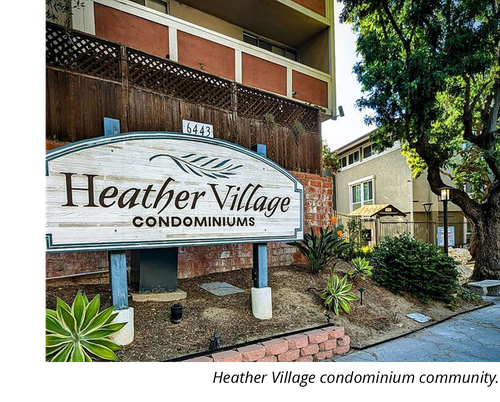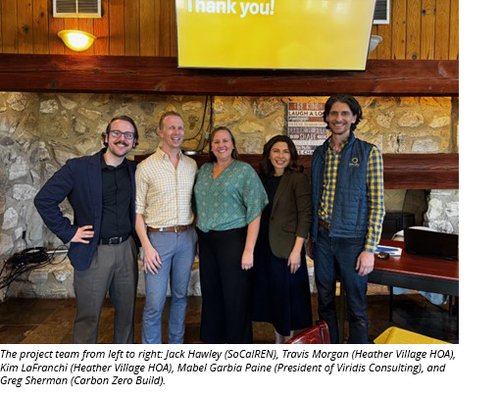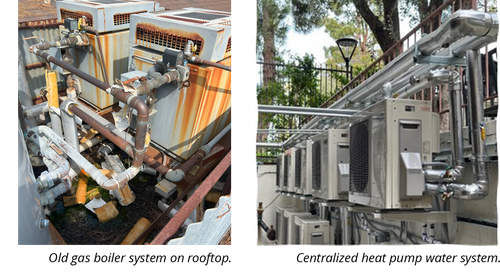A Blueprint for HOA Electrification
March 25, 2025

When the Heather Village homeowner’s association (HOA) needed to replace an aging hot water system, board members saw an opportunity — not just to upgrade, but to save money and shift away from fossil fuels. With help from grants, on-bill financing, and strategic partners, the 12-acre condominium complex west of Los Angeles installed seven central heat pump water heaters to replace a crumbling system of 15 gas boilers. After great initial success, Heather Village is now embracing full electrification, including other appliances and even full HVAC for residents who had never enjoyed air conditioning. The community’s experience offers a blueprint for other HOAs looking to make the switch from gas to electricity.
The story of Heather Village’s success started with failure: In 2022, the rooftop boilers and gas pipes the community relied on for heating water were beginning to fail. Costly replacement was inevitable, but the community did have some choices, said Travis Morgan, who was HOA president at the time. The HOA could stick with gas boilers, shift to a tankless system still fueled by gas, or convert to electric heat pump water heaters. The latter was, by far, the most expensive up-front, Morgan and his colleagues knew, but sustainability grants and financing options had the potential to bring down initial costs substantially.
“We said, ‘Well, we'd rather invest that $5 million in going carbon free and moving toward future technologies, than invest $5 million in natural gas pipelines that are going to be obsolete in 10 to 15 years,’” said Morgan.
Today, all 404 units in the condo community enjoy hot water from a far more efficient system of central heat pump water heaters.
The journey to implementation required overcoming costs and technical challenges, and careful project management. That is exactly the kind of project that TECH Clean California, a statewide initiative to accelerate the adoption of clean space and water heating technology, was designed to address. TECH Clean California provided grant funding to the project through its Quick Start Grant program. Quick Start Grants are administered by VEIC, a clean energy nonprofit, and fund targeted, innovative pilots focused on increasing heat pump space and water heating adoption. That first grant fostered the led to other, more substantial funding, thanks to partnerships forged in the pilot project.
Exploring Hot Water Options for the Community
In 2021, Heather Village’s HOA had already resolved to move toward carbon neutrality. The HOA represents a diverse community, including fixed-income retirees as well as newer, middle-income residents. For simplicity, lower initial costs, and to avoid major disruption, the HOA initially focused on tankless gas water heaters as a replacement. However, such systems are vulnerable to scale buildup, and it quickly became apparent the community’s hard water would represent a costly problem in the long term.
So Morgan, who was interested in heat pump technology, began investigating what it would take to install central heat pump water heating systems. He knew he would need to prove to his fellow board members that the system could be both affordable and reliable. But the switch might help Heather Village deal with a second challenge: some outdated electrical panels with known problems that forced residents to pay extra for fire insurance. An obvious next step would be to conduct a feasibility study to assess whether Heather Village’s infrastructure could support conversion to a central heat pump water heater system and other projects to achieve full electrification, and the costs of doing so. However, the potential cost of such a study — easily $80,000 — was a significant barrier.
This is where the Quick Start Grant came in. Viridis Consulting, a clean energy transition facilitator, introduced the Heather Village HOA to TECH Clean California’s Quick Start Grant funding opportunity.
“I don't think we ever would have gone down this route without a Quick Start Grant,” Morgan said. “I just cannot envision homeowners saying, ‘Yes, spend $80,000 on a study’ that might come back and say, ‘No, you can't do it.’”
TECH Clean California allowed them to take that risk, providing $300,000 not only for the feasibility study, but for a demonstration project as well. The feasibility study soon offered good news: There was sufficient electrical capacity from the meter between Southern California Edison (SCE) and Heather Village to power wholesale conversion from gas water heating to electric. Moreover, the two SCE transformers on the property were being used at such a small percentage that they would not require upgrades.
“That was the big ‘A-ha!’ moment that allowed us to say, ‘Yes, we can move forward with not only this project, but potentially switching over, eventually... to full electrification for the property,’” Morgan said.
Getting Expert Support to Pilot and Scale Improvements
To build out the demonstration heat pump water heater project, and to consider community-wide upgrades, the HOA quickly realized it needed someone who understood the intersection between utilities, government permits, and funding. They found it in Mabell Garcia Paine, Viridis’ owner. Paine served as an independent facilitator on the project, helping the HOA board — which, like most, lacked deep expertise in permitting, contracting, and financing — navigate every step from start to finish.

“Mabell was so valuable because she knows the space, she knows the incentive programs, and she knows the people running the programs, so she can ask the right questions, whereas we don't even know what we don't know,” said Morgan, who is a member of the Heather Village Sustainability Committee, chaired by fellow board member Kim LaFranchi. That committee, LaFranchi said, vets, plans, and oversees all electrification projects, in collaboration with the entire HOA board.
With the Quick Start Grant funding, Paine’s expertise, and the invaluable expertise of engineering company Introba, the HOA replaced one failing boiler system with an electric heat pump and a water heater system. Operational in May 2024, the new central heat pump water heater serves 66 units in four buildings, and post-installation evaluations have been almost universally positive.
The successful demonstration project cracked open the door for the HOA to consider a more comprehensive project: replacing the remaining gas boilers serving other buildings in the complex. Once again, incentives and financing made that next step possible. With Viridis’ support, the HOA applied for, and received, more than $600,000 of multifamily incentive funds through the TECH Clean California program, and additional funding through a SoCalREN incentive program. Finally, they secured a zero percent interest on-bill financing loan from SCE, the first ever awarded to a multifamily property.
“Viridis provided crucial support on the funding and financial side, helping the HOA dig into every option for additional incentives and find financing solutions that made it possible for the HOA to move ahead with the entire water heating and electrification improvements needed,” explained Sarabeth Erdman, an energy efficiency and decarbonization consultant at VEIC.
Six more central heat pump water heaters were installed by the end of December 2025.
Fixing Remaining Electrical Infrastructure

The larger project proved complicated, electrically. Before installation, the HOA had to upgrade 47 distribution panels and many breakers, add some new subpanels to distribute the electrical load, and install new wires. Almost everything was more than 50 years old.
“These were very complicated electrical issues, and we didn't have a good sense of what upgrades were necessary, what could be addressed later, and how much it would all cost,” Garcia Paine said.
It would be necessary to find a contractor who understood the full electrical impacts from new centralized heat pump water heater systems, and especially how that new electrical load would affect the rest of the community’s electricity needs. Moreover, the HOA wanted to ensure that it would be positioned to be able to continue to electrify systems in the future, such as space heating and cooling.
Heather Village contracted with a Northern California firm, Carbon Zero Buildings, an energy efficiency design-build contracting firm, which has both a proven track record in central heat pump water heater installations and showed patience and diligence in identifying and addressing problems individually. And the HOA also hired Penna Electric, a local electrical contract firm.
For the electrification assessment, Carbon Zero Buildings collected data to precisely understand the layout of the electrical wiring, beyond what the feasibility study had included.
“Multifamily buildings tend to be older buildings, full of all kinds of unexpected problems,” said Greg Sherman, cofounder of Carbon Zero. “You've got to do an enormous amount of data collection to uncover all the information that exists at the building today, which is just so different from ground up construction and major rehabs where you're gutting or starting fresh, and everything is drawn and designed on a plan.”
Sherman credited the HOA board with enabling his team’s work. “Heather Village is a very active board and sustainability committee that has the time and willingness to take on these projects that are way more complicated than an in-kind replacement,” Sherman said.
In turn, the board members, in particular those on the sustainability committee, credited Viridis, Introba, and Carbon Zero Buildings with helping them understand different layers of needed information and make many critical decisions along the way.
The Finish Line
The teamwork between the HOA, consultants, and contractors helped Heather Village complete the campus-wide installation in January 2025. While the systems are still being fine-tuned, a pre- and post-installation tenant satisfaction survey revealed promising results.
There’s still work to be done, LaFranchi said, primarily involving pre-existing issues that would have posed challenges with any kind of major installation project, whether gas or electric. She’s optimistic that Heather Village residents will feel satisfied and confident in their water heating system soon
Beyond improving water heating, Heather Village’s transition to electrification has paved the way for future community upgrades, including HVAC and EV chargers — enhancements that not only modernize the community, but may increase property values.
Looking back, Morgan said he’s confident that without financial help, the HOA would have defaulted to gas. “One hundred percent we would have just stayed with gas,” he admitted. “As an HOA board member, I feel that my responsibility is to our most vulnerable homeowners. We can't just assess a $6,000 assessment and just drive people out of their homes.”
Ultimately, the decision to go electric wasn’t the easiest path, but it was the right one, he said. “I mean, the easier choice is just to keep going like it is right now. It was a lot more work to go toward electrification,” he said. The complexities of the upgrades meant that an HOA on its own would not have been able to navigate the transition alone. But with the right support, Heather Village demonstrated the potential for HOA-level decarbonization, something other communities can take inspiration from.
